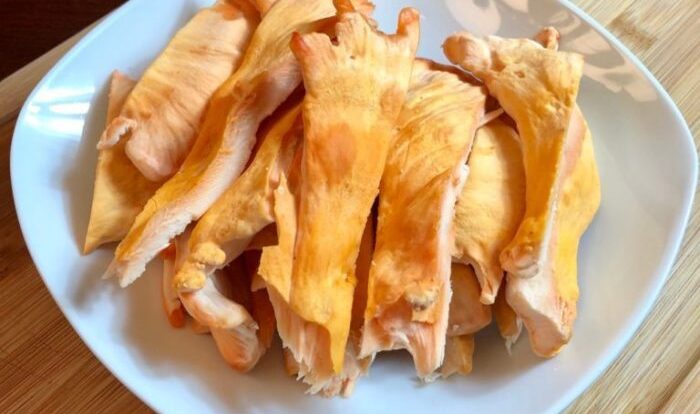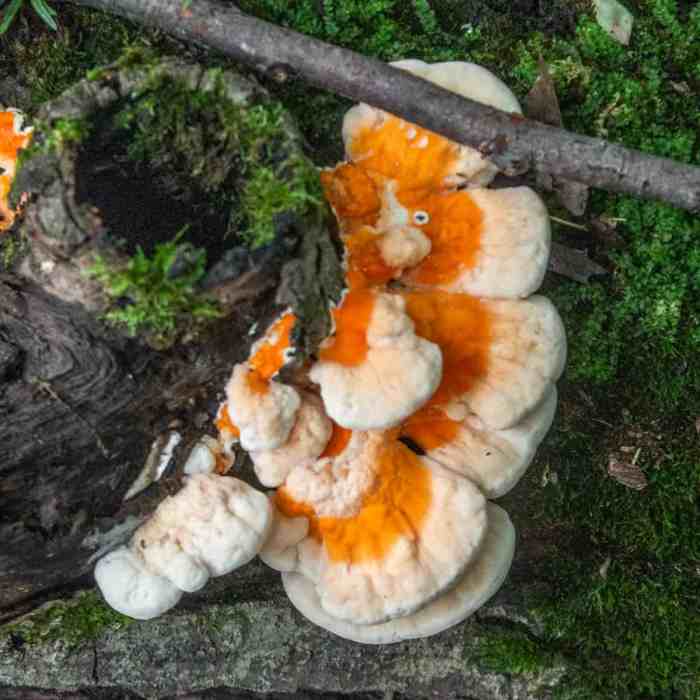
Embark on a culinary adventure with our chicken of the woods recipe, where we’ll forage, identify, and cook this delectable wild mushroom. From its nutritional benefits to creative culinary applications, get ready to savor the wonders of the forest.
As we dive into the world of chicken of the woods, we’ll explore its versatility in soups, stews, stir-fries, and more. Discover how this mushroom enhances vegetarian and vegan dishes, adding a meaty texture and earthy flavor.
Recipe Exploration

Chicken of the woods is a delicious and versatile mushroom that can be cooked in a variety of ways. It has a meaty texture and a slightly nutty flavor, making it a great substitute for chicken in many recipes. Here is a comprehensive recipe for preparing chicken of the woods:
Cleaning and Cutting
To clean chicken of the woods, simply brush off any dirt or debris with a soft brush. Cut the mushroom into 1-inch pieces.
Cooking
Chicken of the woods can be cooked in a variety of ways, including sautéing, roasting, grilling, and frying. To sauté chicken of the woods, heat some olive oil in a large skillet over medium heat. Add the mushroom pieces and cook until browned on all sides.
Season with salt and pepper to taste.
Variations
There are many different ways to vary this recipe. Here are a few ideas:
- Add some chopped onion and garlic to the skillet when sautéing the mushrooms.
- Season the mushrooms with your favorite herbs and spices.
- Roast the mushrooms in the oven with some vegetables.
- Grill the mushrooms over medium heat until cooked through.
- Fry the mushrooms in a hot skillet until golden brown.
Health Benefits
Chicken of the woods is not only delicious, but it also packs a nutritional punch. It is a good source of protein, fiber, vitamins, and minerals.
Chicken of the woods has been shown to have antioxidant and anti-inflammatory properties. Antioxidants help to protect cells from damage, while anti-inflammatories can help to reduce inflammation throughout the body. Some studies have even suggested that chicken of the woods may have medicinal uses, such as helping to treat cancer and diabetes.
Nutritional Value
- Protein: Chicken of the woods is a good source of protein, containing about 20% of the daily recommended value per serving.
- Fiber: Chicken of the woods is a good source of fiber, containing about 10% of the daily recommended value per serving.
- Vitamins: Chicken of the woods is a good source of vitamins, including vitamin C, vitamin D, and vitamin B12.
- Minerals: Chicken of the woods is a good source of minerals, including potassium, phosphorus, and magnesium.
Potential Health Benefits
- Antioxidant properties: Chicken of the woods contains antioxidants that can help to protect cells from damage. These antioxidants may help to reduce the risk of chronic diseases such as cancer and heart disease.
- Anti-inflammatory properties: Chicken of the woods contains anti-inflammatory compounds that can help to reduce inflammation throughout the body. Inflammation is a major risk factor for many chronic diseases, such as arthritis, heart disease, and cancer.
- Medicinal uses: Some studies have suggested that chicken of the woods may have medicinal uses, such as helping to treat cancer and diabetes. However, more research is needed to confirm these potential benefits.
Culinary Applications

Chicken of the woods is a versatile culinary delight, boasting a meaty texture and delicate flavor that lends itself to a wide range of culinary preparations.
Its unique characteristics make it a perfect substitute for chicken in many dishes, while also adding a distinct earthy and umami note.
In Soups and Stews
Chicken of the woods shines in soups and stews, where its meaty texture and savory flavor add depth and richness to the broth.
- Add it to a hearty beef stew for a umami boost and a satisfying bite.
- Incorporate it into a creamy mushroom soup for a earthy and aromatic twist.
- Simmer it in a vegetable broth with root vegetables and herbs for a comforting and flavorful vegetarian soup.
In Stir-fries
Chicken of the woods is a delightful addition to stir-fries, providing a meaty and flavorful element.
- Pair it with vegetables like broccoli, carrots, and snap peas for a colorful and nutritious stir-fry.
- Marinate it in a savory sauce and stir-fry with tofu or tempeh for a vegan alternative to chicken.
- Add it to a classic pad thai for a unique and umami-rich twist.
In Other Dishes
Beyond soups, stews, and stir-fries, chicken of the woods finds its place in a variety of other culinary creations.
- Roast it with vegetables for a hearty and flavorful side dish.
- Bread it and pan-fry it for a crispy and satisfying appetizer.
- Use it as a filling for tacos, burritos, or sandwiches for a unique and umami-packed twist.
Vegetarian and Vegan Options
Chicken of the woods is an excellent meat substitute for vegetarian and vegan diets.
- In vegetarian dishes, it provides a meaty texture and umami flavor, enhancing the overall taste and satisfaction.
- For vegan meals, it offers a satisfying alternative to chicken, providing a similar texture and savory notes.
- Its versatility allows it to be incorporated into a wide range of vegetarian and vegan dishes, adding depth and flavor to every bite.
Foraging and Identification

Chicken of the woods is a versatile edible mushroom that can be found in a variety of habitats, including forests, parks, and even your own backyard. Here’s a guide to help you identify and forage for this delicious fungus:
Identification Tips
* Shape and Size:Chicken of the woods grows in clusters or shelves on trees or logs. The clusters can be large, up to 12 inches across, and have a distinctive fan-shaped appearance.
Color
The upper surface of the mushroom is typically bright orange to yellow, while the underside is white or cream-colored.
Texture
The flesh of chicken of the woods is firm and slightly rubbery when raw. It becomes tender when cooked.
Smell
Chicken of the woods has a mild, pleasant smell that is somewhat fruity.
Similar Species, Chicken of the woods recipe
There are a few similar-looking species that can be mistaken for chicken of the woods. Here are some tips to help you distinguish them:* False Chicken of the Woods (Laetiporus sulphureus): This species has a similar appearance to chicken of the woods but is typically a brighter orange color.
It also has a stronger sulfurous smell.
Chicken of the woods is a versatile mushroom that can be used in a variety of dishes. It is a good source of protein, fiber, and vitamins. If you’re looking for a delicious and healthy chicken of the woods recipe , there are many to choose from.
One popular recipe is to simply sauté the mushrooms in butter or olive oil with some garlic and herbs. Another option is to grill the mushrooms and serve them with a dipping sauce.
Sulphur Shelf (Laetiporus gilbertsonii)
This species is also orange but has a more shelf-like shape. It has a strong sulfurous smell and is not edible.
Chicken of the Woods Look-alike (Albatrellus confluens)
This species has a similar fan-shaped appearance but is a paler orange color. It is edible but has a tough texture.
Responsible Harvesting
When foraging for chicken of the woods, it is important to practice responsible harvesting practices. This includes:* Only harvesting from healthy trees or logs:Avoid harvesting from trees or logs that are diseased or damaged.
Leaving some mushrooms behind
Leave some mushrooms behind for wildlife and to ensure the long-term survival of the population.
Using a sharp knife to cut the mushrooms
Chicken of the woods is a type of mushroom that can be found in forests all over the world. It is a delicious and nutritious mushroom that can be used in a variety of dishes. If you’re looking for a chicken of the woods recipe , there are many to choose from.
One popular recipe is to simply sauté the mushrooms in butter or olive oil with some garlic and herbs. Another option is to grill the mushrooms and serve them with a dipping sauce.
This will help to prevent tearing the mushrooms and damaging the tree or log.
Comparative Analysis
Chicken of the woods is often compared to other popular edible mushrooms like oyster mushrooms and shiitake. While they share some similarities, there are also notable differences in their taste, texture, and nutritional value.
Taste and Texture
- Chicken of the woods:Has a meaty, savory flavor with a slightly nutty undertone. Its texture is firm and slightly chewy when cooked.
- Oyster mushrooms:Known for their mild, earthy flavor and tender, meaty texture.
- Shiitake mushrooms:Have a rich, umami flavor with a slightly woody aroma. Their texture is firm and slightly crunchy.
Nutritional Value
All three mushrooms are good sources of dietary fiber, protein, and antioxidants. However, there are some variations in their nutritional profiles:
| Nutrient | Chicken of the Woods | Oyster Mushrooms | Shiitake Mushrooms |
|---|---|---|---|
| Protein | 12% | 10% | 15% |
| Fiber | 15% | 12% | 10% |
| Vitamin C | 20% | 15% | 10% |
| Potassium | 10% | 12% | 15% |
End of Discussion

Whether you’re a seasoned forager or a curious home cook, our chicken of the woods recipe empowers you to harness the culinary potential of this wild mushroom. Embrace its unique taste, embrace its health benefits, and elevate your meals with the flavors of the forest.
Essential FAQs: Chicken Of The Woods Recipe
Can I eat chicken of the woods raw?
No, it’s not recommended to eat chicken of the woods raw as it may cause stomach upset.
How do I clean chicken of the woods?
Gently brush off any dirt or debris with a soft brush or damp cloth. Cut away any tough or woody parts.
Can I freeze chicken of the woods?
Yes, you can freeze cooked chicken of the woods for up to 3 months. Thaw before using.





